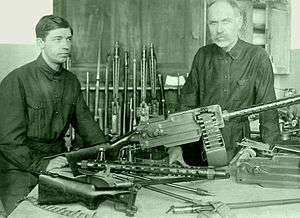Maxim–Tokarev
| Maxim-Tokarev | |
|---|---|
|
Tokarev and his son posing with their model 1925 machine gun | |
| Type | Light machine gun |
| Place of origin | Soviet Union |
| Service history | |
| Used by | Soviet Union |
| Production history | |
| Designer | Fedor Tokarev |
| Number built | 3,500 |
| Specifications | |
| Weight |
12.9 kg (empty) 15.5 kg (with typical ammo load)[1] |
| Length | 1330 mm[1] |
| Barrel length | 650 mm[1] |
|
| |
| Cartridge | 7.62×54mmR |
| Caliber | 7.62 mm |
| Action | Short recoil, toggle locked |
| Feed system | belt-feed, 100 rounds belt |
| Sights | iron |
The Maxim–Tokarev was the first domestic Soviet light machine gun accepted for service. It was based on the Maxim M1910.
History
During World War I and the Russian Civil War, the Soviet army was equipped with light machine guns of foreign manufacture, mostly with the Lewis gun, the Chauchat and the Hotchkiss M1909. By the 1920s, these guns were showing their age, and owing to the Soviet Union's international diplomatic isolation, neither spare parts nor ammunition could be easily obtained for these guns. Consequently, in 1923 an emergency program was initiated for equipping the Red army with a light machine gun chambered for the domestic 7.62×54mmR. The first design submitted was the Maxim-Kolesnikov, followed soon thereafter by the Maxim–Tokarev. During field tests conducted in early 1925, Tokarev's model proved superior, so it was adopted on May 26.[2]
The Maxim–Tokarev was replaced in Soviet service by the much lighter DP. [3]
Structure
A US Army analysis mentions that "Tokarev was doubtless inspired by both the German Parabellum and the British Vickers. The arrangement of the trigger and the shoulder stock resembles very strongly that illustrated in United States Patent No. 942167, which was granted in 1909 to Dawson and Buckham, assignors to Vickers."[4]
The water jacket of the Maxim M1910 was discarded and replaced by a thin perforated steel jacket. The barrel was shortened and lightened from 2.1 kg to 1.7 kg. A mechanism for changing the barrel in field conditions was provided. The spade grips were replaced with a rifle-type stock and the thumb-trigger was replaced by a rifle-type trigger. A folding bipod with tubular legs was attached to the barrel jacket.[1]
The canvas-belt feed system was the same as on Maxim M1910 guns, except the standard belt capacity was reduced to 100 rounds. The 100-round belts were usually carried in separate drum-type containers, inspired from the MG 08/15. The barrel rifling was 4 right-turns in 240 mm.[1]
More than 3,500 Maxim–Tokarev guns were produced by Tula arms factory (TOZ) in 1926-27; 3,550 were later sold to Republican Spain and 1,400 to Republic of China.
User
See also
References
- 1 2 3 4 5 Семен Федосеев (2009). Пулеметы России. Шквальный огонь. Яуза / Коллекция / ЭКСМО. pp. 380–381. ISBN 978-5-699-31622-9.
- ↑ Болотин, Давид (1995). История советского стрелкового оружия и патронов (in Russian). Полигон. pp. 166–167. ISBN 5-85503-072-5.
- ↑ James H. Willbanks (2004). Machine Guns: An Illustrated History of Their Impact. ABC-CLIO. p. 99. ISBN 978-1-85109-480-6.
- ↑ Chinn, George M. The Machine Gun, Vol II, Part VII. US Department of the Navy, 1952, page 23
- Musgrave, Daniel D.; Thomas B. Nelson (1967). The World's Assault Rifles and Automatic Carbines. T. B. N. Enterprises. p. 150.
- Barker, A. J.; John Walter (1971). Russian Infantry Weapons of World War II. New York: Arco Pub. Co. p. 35. ISBN 0-668-02336-8.
- Bingham-Black Smith, Walter Harold; Joseph E. Smith (1975). Small Arms of the World: A Basic Manual of Small Arms (10th ed.). London: A and W Visual Library. p. 547. ISBN 0-89104-021-8.
- Dunn, Walter Scott (1995). The Soviet Economy and the Red Army, 1930-1945. Westport, Conn.: Praeger Security International. p. 101ff. ISBN 0-275-94893-5.
- Hogg, Ian V.; John S. Weeks (2000). Military Small Arms of the 20th Century (7th ed.). Iola, Wis.: Krause Publications. p. 359f. ISBN 0-87341-824-7.
- Tucker, Spencer; Jinwung Kim (2000). Encyclopedia of the Korean War: A Political, Social, and Military History. Oxford: ABC-CLIO. p. 407. ISBN 1-57607-029-8.
